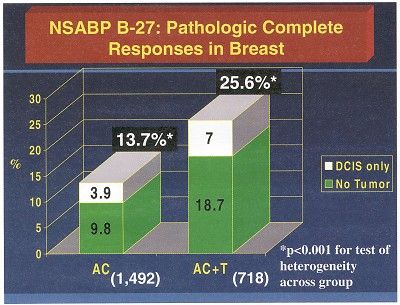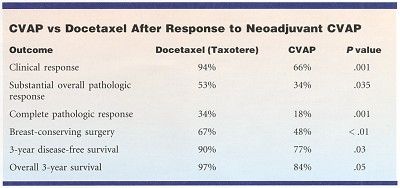Docetaxel Plus Neoadjuvant AC Increases Pathologic Complete Responses in Breast Cancer
SAN ANTONIO-The sequential use of docetaxel (Taxotere) after Adriamycin (doxorubicin)/cyclophosphamide (AC) as a neoadjuvant regimen in primary operable breast cancer essentially doubles the rate of pathologic complete responses (CRs),
SAN ANTONIOThe sequential use of docetaxel (Taxotere) after Adriamycin (doxorubicin)/cyclophosphamide (AC) as a neoadjuvant regimen in primary operable breast cancer essentially doubles the rate of pathologic complete responses (CRs), according to final response data from the National Surgical Adjuvant Breast and Bowel Project (NSABP) Protocol B-27.
NSABP B-27, reported at the 24th Annual San Antonio Breast Cancer Symposium (abstract 5), evaluated neoadjuvant AC (60/600 mg/m² every 3 weeks) and docetaxel (100 mg/m² every 3 weeks) in 2,411 patients with large operable breast tumors.
Patients were randomized to four cycles of AC followed by surgery (group 1); four cycles of AC followed by four cycles of docetaxel and then surgery (group 2); or four cycles of AC, then surgery, followed by four cycles of docetaxel (group 3). For purposes of the response rate analyses, groups 1 and 3 were combined into the AC group and compared with group 2, the AC/T group.
The sequential use of docetaxel after preoperative AC increased the breast tumor pathologic complete response rate by 87%, clinical complete response rate by 60%, and lymph-node-negative status by 15%, reported Harry D. Bear, MD, PhD, professor of surgery, Virginia Commonwealth University, Richmond.
The prior NSABP B-18 trial showed improved survival in patients who achieved a pathologic complete response; however, in that trial, neoadjuvant AC produced only a 13% pathologic complete response rate. The aim of B-27 was to determine whether the addition of a taxane to AC neoadjuvant therapy would improve pathologic complete response rates and multiple outcomes.
Survival analyses will be conducted later, but Dr. Bear commented on the potential effect. "We know that pathologic response to a given regimen predicts overall outcome in terms of survival. But we don’t know whether that is because of the treatment or the biology of the tumor. This trial will be one of the first to answer the question, ‘If you change the treatment to increase the response rate, will you also get an improved survival?’
If the docetaxel group has a better survival, he said, "this will tell us that local response is truly a surrogate for outcome in terms of survival. We can then use this in subsequent trials as an endpoint. I am very optimistic, but we don’t yet have the data on long-term follow-up."

NSABP B-27 did, indeed, show that by adding docetaxel, the pathologic complete response rate was increased from 13.7% to 25.6%. No tumor was identified in 18.7% of surgical specimens in AC/T vs 9.8% of specimens from AC patients; ductal carcinoma in situ (DCIS) was the only remaining lesion in 7% and 3.9%, respectively. These differences were highly statistically significant (P < .001), Dr. Bear reported.
Nodal status was also positively influenced by docetaxel, though more modestly. But the AC/T regimen did not significantly improve the rate of breast-conserving surgery. Lumpectomy was performed on 61.4% of patients after AC and 63.1% after AC/T. The already high rate of lumpectomies in this optimally treated population is difficult to improve upon, Dr. Bear explained.
Toxicity was slightly higher with the addition of docetaxel, attributed mainly to the occurrence of several cases of bowel perforation. This complication was virtually eliminated when the premedication steroid dose was reduced. Docetaxel recipients had more grade 4 toxicities (24% vs 10%) and deaths (6 patients vs 1 patient). There was no difference in rate of infection.
Aberdeen Neoadjuvant Study
In another phase III neoadjuvant study presented at the meeting (abstract 506), University of Aberdeen investigators showed that giving docetaxel after response to anthracycline-based primary chemotherapy (CVAP) resulted in a significantly higher clinical response than can be achieved by four further cycles of CVAP (cyclophosphamide, doxorubicin, vincristine, prednisolone). The median follow-up is now at 38 months.
The study included 167 patients with large and locally advanced breast cancer who received four cycles of CVAP preoperatively. The 104 patients with a clinical response were randomized to receive either another four cycles of CVAP or four cycles of docetaxel.

Andrew Hutcheon, MD, reported that, among 97 evaluable patients, the results favored the docetaxel arm after eight cycles of neoadjuvant chemotherapy. "I think when you give the doxorubicin regimen, you destroy a lot of cancer cells. But if you then give docetaxel, you will kill the cells that are resistant to doxorubicin and this will give you better survival," he suggested.
Newsletter
Stay up to date on recent advances in the multidisciplinary approach to cancer.